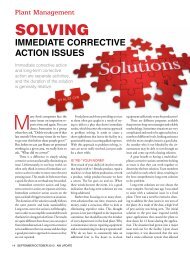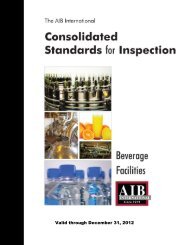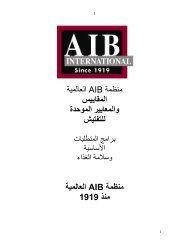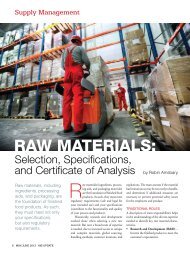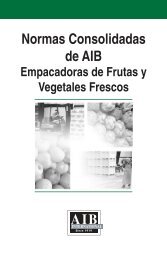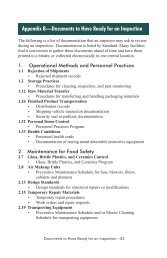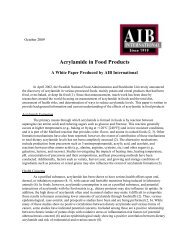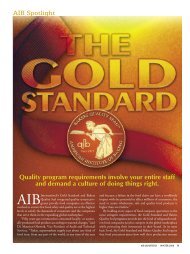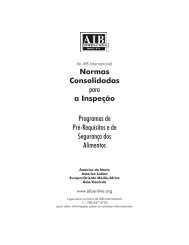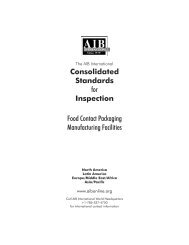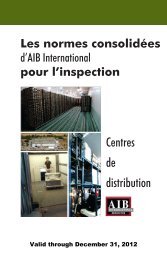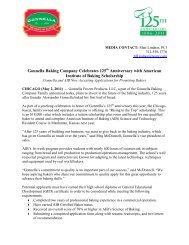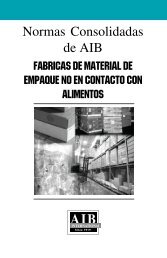State of Mind - AIB International, Inc.
State of Mind - AIB International, Inc.
State of Mind - AIB International, Inc.
Create successful ePaper yourself
Turn your PDF publications into a flip-book with our unique Google optimized e-Paper software.
<strong>State</strong> <strong>of</strong><br />
<strong>Mind</strong><br />
Develop a food protection culture at<br />
your plant by honestly evaluating the<br />
current state <strong>of</strong> your training process<br />
and implementing specific procedures to<br />
improve that process.<br />
By Galen Haar<br />
6 september/october 2010 <strong>AIB</strong> UPDATE<br />
During my career as a<br />
Food Safety Auditor,<br />
I have experienced at<br />
least a dozen audit schemes<br />
that focus on the evaluation <strong>of</strong><br />
the effectiveness <strong>of</strong> the food protection<br />
programs that have been<br />
implemented at a food processing<br />
facility. One <strong>of</strong> the common criteria<br />
in each <strong>of</strong> these schemes is training<br />
<strong>of</strong> plant personnel, including managers.<br />
Companies that are involved in the food<br />
supply chain, from ingredients and packaging<br />
suppliers to finished food producers<br />
and distributors, are expected to provide<br />
training to all staff members. This training<br />
could include subjects such as Good<br />
Manufacturing Practices (GMPs), Allergens,<br />
Hazardous Analysis Critical Control<br />
Point (HACCP), Sanitation, Integrated<br />
Pest Management (IPM), Food Defense,<br />
Foreign Material Control, Personal Hygiene,<br />
and so forth.<br />
Training is defined as “developing or<br />
forming the habits, thoughts or behavior<br />
<strong>of</strong> a person by discipline and instruction;<br />
to make pr<strong>of</strong>icient by instruction<br />
and practice.” 1 However, my experiences<br />
1<br />
Random House College Dictionary
Continuing Education<br />
do not show that our industry’s training<br />
programs are always producing the desired<br />
results. I frequently review food protection<br />
training programs and am shown elaborate<br />
computer or video presentations that are<br />
used to relay this information. Attendees<br />
sign a sheet to show they have participated<br />
in the training and may even complete a<br />
quiz to show they absorbed at least some<br />
<strong>of</strong> the information that was presented. I<br />
then do a physical inspection in the plant<br />
and find numerous examples <strong>of</strong> violations<br />
<strong>of</strong> the plant’s policies and procedures. Here<br />
are a few real-life experiences to support<br />
my point.<br />
During one inspection, I walked up<br />
1. to a conveyor on which exposed food<br />
product was being transported. An operator<br />
was standing near the belt, right next to a<br />
drive motor and gear box assembly that was<br />
mounted above the product stream and had<br />
a shallow (~½” deep) catch pan installed below<br />
it. As I approached, I noticed a slow but<br />
steady drip coming from the catch pan and<br />
falling onto the food product below. Upon<br />
closer inspection, I discovered the gear box<br />
was leaking lubricant and the catch pan was<br />
overflowing. A little additional investigation<br />
revealed that the operator had attended all<br />
the facility’s food protection training sessions<br />
for the past several years, had signed<br />
the training log, and had successfully completed<br />
the related quizzes. So why did this<br />
operator not notice, and react appropriately,<br />
to the food product contamination event<br />
that was occurring about three feet from<br />
where he was standing?<br />
During an inspection <strong>of</strong> the outside<br />
2. grounds at another plant, we came to<br />
the area where bulk liquids were received<br />
(i.e. edible oils, liquid sweeteners, etc). I<br />
asked to view the in-line receiving strainers<br />
and my escort went to find one <strong>of</strong><br />
the receiving workers. The receiver soon<br />
appeared with the tools needed to open<br />
the receiving ports so I could inspect the<br />
strainers. As he removed the strainer basket<br />
from the first port, I noticed something<br />
odd at the bottom <strong>of</strong> the basket. Upon<br />
closer examination, I found that two 3 ⁄8”<br />
holes had been drilled into the bottom <strong>of</strong><br />
this basket. I questioned the receiver and<br />
learned: “The truck drivers were complaining<br />
there was too much back-pressure in<br />
this line for them to be able to run their<br />
discharge pumps at full speed. So I took<br />
the strainer basket to the shop and fixed<br />
it.” Once again, food protection training<br />
records were available to show this worker<br />
had experienced all the plant’s training<br />
sessions for some years.<br />
While inspecting a line in the finished<br />
3. product packaging area at a plant, I<br />
asked my escort to find the person who<br />
was responsible for monitoring the metal<br />
detector (CCP) on that line. This operator<br />
proceeded to show me the procedure<br />
she used to challenge the metal detector.<br />
The test pieces did trigger the detector<br />
and activated the alarm and reject mechanism.<br />
However, the timing <strong>of</strong> the reject<br />
device was not set correctly and all three<br />
test pieces continued down the packaging<br />
line unaffected. I questioned the operator<br />
only to learn that, “This thing does that<br />
a lot. I’ll try to remember to get one <strong>of</strong><br />
the maintenance guys to adjust it later.<br />
We have to finish this run by the end <strong>of</strong><br />
the shift.” Guess what? Current training<br />
records were also available for this person<br />
and her supervisor.<br />
Do you notice a pattern from these<br />
examples? The workers in these scenarios<br />
had all experienced their plant’s training<br />
programs, in some cases, multiple times.<br />
Yet, this training had failed to form the<br />
habits, thoughts or behaviors <strong>of</strong> the person<br />
in the most effective manner.<br />
Based on my experience with more<br />
successful training programs, I can <strong>of</strong>fer<br />
some ideas that may or may not apply to<br />
the situation at your plant. Evaluate your<br />
own training process with these suggestions<br />
in mind and determine how you can<br />
improve the effectiveness <strong>of</strong> the investment<br />
you’re making.<br />
VALUED TRAINING<br />
Sometimes, training becomes a repetitive<br />
event. You have to do it to comply with<br />
company requirements and so you have<br />
acceptable records available for your next<br />
third-party audit. However, many companies<br />
have used the same training material<br />
for years and <strong>of</strong>fer the same routine presentation<br />
each time. Most staff members have<br />
seen this training several times and tend to<br />
nap through the event.<br />
When the session is finished, you might<br />
have everyone sign a record to show they<br />
have attended the training. Then you<br />
collect the record, place it into a properly<br />
labeled folder, and breathe a sigh <strong>of</strong> relief<br />
that the event is over until next year.<br />
Or maybe you give each department<br />
shift supervisor a training guide and tell<br />
them to review it with their staff during<br />
the next shift meeting. Again, you make<br />
sure they obtain a record <strong>of</strong> the people who<br />
have been exposed to this training. Have<br />
you really <strong>of</strong>fered anything that employees<br />
consider valuable? Have you helped your<br />
personnel “develop or form the habits,<br />
thoughts or behaviors” that will enhance<br />
your food protection programs? It is your<br />
responsibility to make training interesting<br />
and effective. Find some way to <strong>of</strong>fer<br />
your personnel adequate training so they<br />
can help maintain your food protection<br />
programs successfully.<br />
TRAINING EVALUATION<br />
How do you determine if the attendees<br />
have clearly understood and retained the<br />
important information the training has<br />
provided? This can represent a significant<br />
challenge. You may have a sign-<strong>of</strong>f form<br />
that states something like, “By signing<br />
below, I confirm that I have received the<br />
training noted and that I understand the<br />
material that was presented.” But, what<br />
does this record provide in the way <strong>of</strong> real<br />
feedback? Probably only that each attendee<br />
can sign their own name!<br />
Others may use an oral quiz with<br />
questions that the group can answer. This<br />
method is a great way to determine which<br />
members <strong>of</strong> your staff are happy to speak for<br />
the rest <strong>of</strong> the group while everyone else nods<br />
their head in agreement with the spokesperson.<br />
If you intentionally direct questions<br />
to individuals, you risk embarrassing and<br />
alienating some members <strong>of</strong> the staff.<br />
You could consider a written quiz that<br />
participants must complete individually.<br />
But first determine if everyone has the skills<br />
needed to take a real quiz or would you<br />
have to create simple true/false questions<br />
that don’t provide much verification <strong>of</strong> the<br />
september/october 2010 <strong>AIB</strong> UPDATE 7
Continuing Education<br />
training’s effectiveness? Can you confirm<br />
that all attendees heard what you were<br />
saying and understood the message you<br />
were trying to convey? Have you effectively<br />
“made your staff pr<strong>of</strong>icient by instruction<br />
and practice”?<br />
A real quiz may be a good place to start.<br />
Determine the most critical training points<br />
for the session and write clear, concise<br />
questions that address these points. A mix<br />
<strong>of</strong> true/false and multiple choice questions<br />
might be best. Eight to 10 questions may<br />
be enough to let you know who needs additional<br />
help. To ensure that all participants<br />
can understand the questions and the<br />
possible answers, read each one out loud<br />
and give them a few minutes to mark the<br />
answer on their quiz. Follow up by<br />
asking supervisors to observe and<br />
orally quiz personnel on a one-onone<br />
basis during the next week or<br />
two. Make sure each supervisor<br />
records his experiences and gives<br />
you a written report. This provides<br />
additional verification <strong>of</strong> the effectiveness<br />
<strong>of</strong> the training, and helps<br />
you identify individuals that may<br />
need some extra coaching.<br />
TRAIN YOUR TRAINERS<br />
Have any <strong>of</strong> your trainers experienced<br />
“train-the-trainer” events in the past<br />
few years? If not, how current is their<br />
knowledge <strong>of</strong> the material that is being<br />
presented? It could make a significant<br />
difference in the effectiveness <strong>of</strong> the training<br />
if trainers refresh their knowledge<br />
and presentation skills on a regular basis.<br />
There are many opportunities for them to<br />
attend live seminars or to participate in<br />
online courses. Having well equipped and<br />
confident trainers may help to establish a<br />
more effective food protection paradigm<br />
throughout the plant. These trainers could<br />
even hold spontaneous “mini-sessions” on<br />
the production floor when they notice a<br />
need for some subject-specific coaching.<br />
This could result in plant workers feeling<br />
that the company is seriously committed<br />
to food protection training and making a<br />
greater effort to support it.<br />
OUTSIDE RESOURCES<br />
Is all <strong>of</strong> your food protection training<br />
done using in-house trainers? Perhaps you<br />
should hire an outside resource for some<br />
training sessions. This would expose everyone<br />
in the company to different training<br />
techniques, styles and experiences. A good<br />
pr<strong>of</strong>essional trainer can make a mundane<br />
subject interesting and even exciting.<br />
People learn better when you capture their<br />
attention with entertaining presentation<br />
techniques and reinforce the message with<br />
experience-based examples. Pr<strong>of</strong>essional<br />
trainers work hard to develop this level <strong>of</strong><br />
effectiveness.<br />
OFFER INCENTIVES<br />
Have you developed a program to recognize<br />
and reward the champions that work on<br />
Have you developed a program to recognize<br />
and reward the champions that work on<br />
your production lines? Peer training and<br />
reinforcement can have a very positive impact if<br />
properly directed. You could create an incentive<br />
system that would benefit individuals who are<br />
“caught doing something right.”<br />
your production lines? Peer training and<br />
reinforcement can have a very positive<br />
impact if properly directed. You could<br />
create an incentive system that would<br />
benefit individuals who are “caught doing<br />
something right.”<br />
When you notice someone who is particularly<br />
involved in some aspect <strong>of</strong> food<br />
protection, invite that person to participate<br />
in the next training session. Maybe they<br />
could speak for just a few minutes about<br />
some experience they have had that relates<br />
to food protection. You could also ask this<br />
person to do some individual coaching<br />
with new employees as part <strong>of</strong> their initial<br />
orientation program. Search for additional<br />
resources that exist within your personnel<br />
pool and use those resources to enhance<br />
your training/coaching programs.<br />
TARGET TOPICS<br />
Internal promotions that are designed<br />
to strengthen targeted areas <strong>of</strong> your food<br />
protection programs may be a great way<br />
to enhance your efforts. Pick a subject, like<br />
hand washing, and do a campaign for a few<br />
weeks to raise awareness <strong>of</strong> the importance<br />
<strong>of</strong> this personal hygiene practice. Use<br />
posters, blurbs in the company newsletter,<br />
short examples at shift meetings, etc., to<br />
promote proper hand-washing techniques.<br />
After a few weeks, move on to another<br />
subject. This would be a great project for<br />
your sales/marketing departments to be<br />
involved with. These folks are pr<strong>of</strong>essional<br />
“promoters” and spend much <strong>of</strong> their time<br />
trying to get buyers and consumers to think<br />
in a certain way.<br />
EMPHASIZE CLIENT EXPECTATIONS<br />
Also, continuously emphasize that customers<br />
expect extremely effective food protection<br />
programs. Remind personnel<br />
that these customers will ultimately<br />
determine the future <strong>of</strong> the plant<br />
and all its members. Effective food<br />
protection is not something that is<br />
being mandated by the management<br />
team. It is simply part <strong>of</strong> what is<br />
expected <strong>of</strong> the food processing<br />
industry.<br />
Effective training amounts to<br />
developing a targeted state <strong>of</strong> mind<br />
among the food plant’s population.<br />
If you have been successful, you should<br />
notice that staff members police each other,<br />
regularly bring improvement suggestions<br />
to you, voluntarily help with training new<br />
workers, are concerned about the results<br />
<strong>of</strong> product protection audits/inspections,<br />
ask many questions <strong>of</strong> you and their supervisors,<br />
routinely tell you about potential<br />
food protection issues they notice, and<br />
generally manage the programs from the<br />
plant floor.<br />
At this point, you may be thinking that<br />
I am proposing a fantasy world, but I have<br />
experienced some plant cultures that closely<br />
mirrored this picture. I believe these plants<br />
have worked very hard and for a very long<br />
time to develop the food protection culture<br />
that permeates their operations. Get started<br />
by honestly evaluating the current state <strong>of</strong><br />
your training process and implementing<br />
procedures to improve the results <strong>of</strong> this<br />
process. <strong>AIB</strong><br />
The author, a 25-year veteran <strong>of</strong> the food processing<br />
industry, is an auditor for <strong>AIB</strong> <strong>International</strong>.<br />
8 september/october 2010 <strong>AIB</strong> UPDATE



